Electricity at the campsite – how does it all work again?
15 May, 2018 | Update: 30/04/2024
You’ve just enjoyed a delicious home-made camping dinner while watching the Italian sunset. The washing up’s been done, and now it’s time to relax. The coffee is gently dripping from the machine, and as it’s still quite warm, you decide to put the ventilator on again for a little while. And then…Pow! The electricity is out!
What’s probably happened is that you’ve exceeded the campsite limit and so their fuse has tripped. With a little luck, the campsite reception is still open and the connection can be restored, otherwise you’ll have to spend the rest of the evening (and the early morning) in the dark. Not a complete disaster, but it can be annoying, and you won’t make the campsite owner happy either. So it’s a good idea to keep an eye on your energy usage at the campsite, to try to avoid this kind of thing.
Read all about power consumption at the campsite
- Amps, watts and voltage
- Calculate your energy usage
- How many watts do my appliances use?
- Electricity at the campsite
- Generate your own power with solar panels
- Extra tips
Amps, watts and voltage
But just how do you do that? After all, you’re not an electrician, and thinking about terms like voltage, watts and amps makes your head spin. Time to refresh your basic knowledge. The electricity connection at the campsite is often shown with a number of amps (for example, ten amps (10A). If you use more than that, the fuse will blow, and you’ll be without electricity. Even if your caravan has a fuse for up to sixteen amps (16A). The lower value is the determining one, and will blow first.
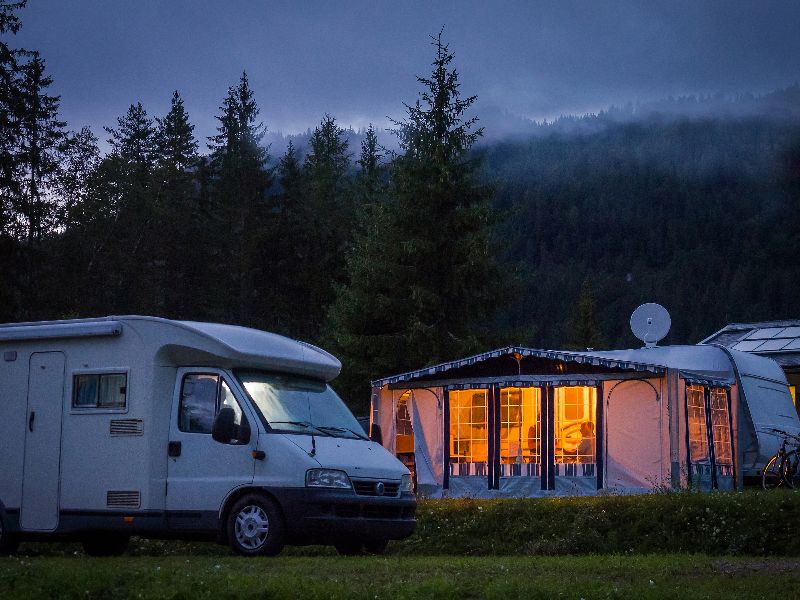
The stove is burning and the lights are on. Are you careful not to use too much electricity on the campsite?
Your appliances use electricity, and the amount they use is shown in a number of watts. Most appliances show the number of watts that they use. But how do you figure out the connection between amps and the number of watts? Luckily there’s an easy equation you can use!
Calculate your energy usage
To use this equation, you’ll also need to know the voltage. Luckily, in Europe, that’s almost always the same number: we use 230 volts. If you’re camping in Europe then, you get this number for free. In order to know the maximum number of watts you can use, you’ll need to multiply the number of amps by the voltage. With this equation, you should be able to tell which appliances you can use at the same time, and which you can’t. The formula is pretty simple:
Amps x voltage (230) = watts
For example: 10 amps x 230 volts = 2,300 watts
Imagine that the campsite connection is ten amps, then you can use a maximum of 2,300 watts at the same time (10 amps x 230 volts). The formula works backwards too. If you know how many watts you need to use at the same time, you can calculate the number of amps your connection needs to have. The formula then becomes:
Watts / voltage (230) = Amps
For example: 2,500 watts / 230 volts = 10.87 amps
No interest in doing maths on your holiday? Here are some of the most common electricity connections (in amps) with the matching total number of watts:
- 4 amps = 920 watts
- 6 amps = 1,380 watts
- 8 amps = 1,840 watts
- 10 amps = 2,300 watts
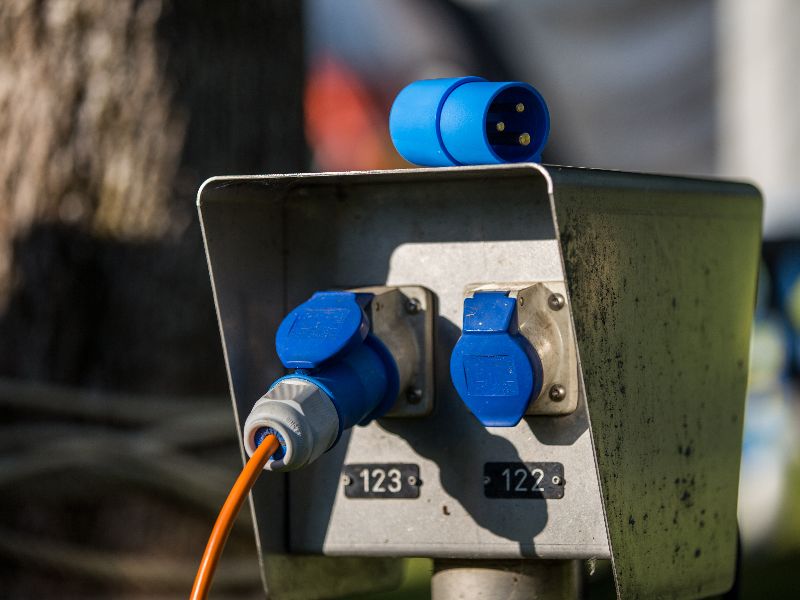
To know how many watts you can consume at the most at the same time, multiply the number of amps by the voltage.
How many watts do my appliances use?
So in order to know which appliances you can use at the same time, you’ll need to do a little adding up. Then you’ll quickly know what combinations are possible. The usage in watts is mostly shown on the appliance, but to give you some idea, here is a list of the number of watts used by a few of the most common appliances:
- Small heater: 750 – 1,500 watts
- Small coffee machine: 600 – 800 watts
- Small oven: 600 – 800 watts
- Charging electric bicycle: 300-500 watts
- Fridge: 70 – 80 watts
- Lights: 30 – 40 watts
- Small TV: 30 – 40 watts
Please note: in the examples above, we’ve given the details for special camping appliances, which tend to use less than normal household appliances.
Electricity at the campsite
When you book a camping pitch, you’ll often be able to see how many amps the electricity connection is. You can also find this out on Eurocampings.co.uk using the filter menu Pitch amenities and it should be possible to find it on the campsite’s website too. If you’re not sure, check with the campsite.
Before you book, think about how much electricity you’ll need to use during your holiday too. If you’re going back to basic and camping in the countryside, you might not even need an electricity connection, or a connection with 2 or 4 amps may suffice. If you want to keep your fridge running while you watch TV and brew some coffee, then you’ll need a connection with a higher number of amps.
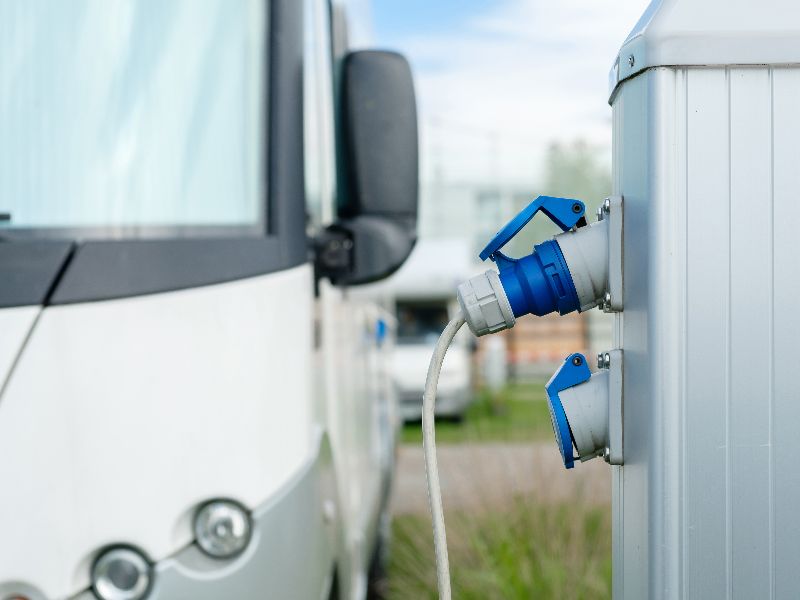
When booking your camping pitch, think about how much electricity you are going to use during your camping holiday.
Generate your own own power with solar panels
You see it more and more often. A set of solar panels is installed on the roof of the motorhome or caravan, allowing you to generate your own power. This way you are less dependent on the electricity at the campsite, and it is easier to camp in the countryside. However, a good battery is a must so that you can store the energy you have generated in order to use it once the sun has gone down.
Extra tips
1. Be aware of peak current
The biggest trap you might fall into when calculating your energy usage is not taking into account peak current, or the inrush current. At the moment you switch on your appliance, it briefly uses (much) more electricity than the normal wattage. Sometimes two or three times as much. So switch on the appliances that use the most electricity first, and take turns switching things on!
2. Hot appliances use more
What if you don’t know the wattage of a certain appliance, and you’re not sure if you can use it? A good rule of thumb is that appliances that get hot use more than other appliances. Take another look at the list in this article. The heater, the oven and the coffee machine are at the top for a good reason. You may well have to wait with switching the coffee machine on until you’ve taken your fresh rolls out of the oven, or turned off the heater.
3. Current limiters
Even if you’re careful and you’ve done all your maths, you won’t be the first camper to have problems from time to time. Luckily, there are current limiters available that can help you to keep an eye on your energy usage and regulate it. But they all have their positives and negatives – so make sure you do some research online or in the shop, to see which will best suit your needs.
4. Safety first
For many people, power is something abstract and, if you don’t handle it properly, it can even be dangerous. Make sure that you handle it sensibly and safely. For example, only use watertight and fused CEE plugs (the so-called blue plug), sockets and camping extension cables. Don’t forget to unroll the entire length of an extension cable on a roll. This prevents fires due to the cables overheating!
5. Campsite with a charging station for an electric car
A growing number of campsites have charging stations for electric cars available. This is quick and safe. View here more than 1600 campsites with a charging station in Europe.
If a charging station is not available at the campsite, some campsites allow you to charge your car at the power pole at your pitch. Do always check with the campsite owner first and check which socket is suitable for this. The charging point must be connected to a separate fused group. Use a special charging cable for this and keep in mind that charging this way takes a long time.
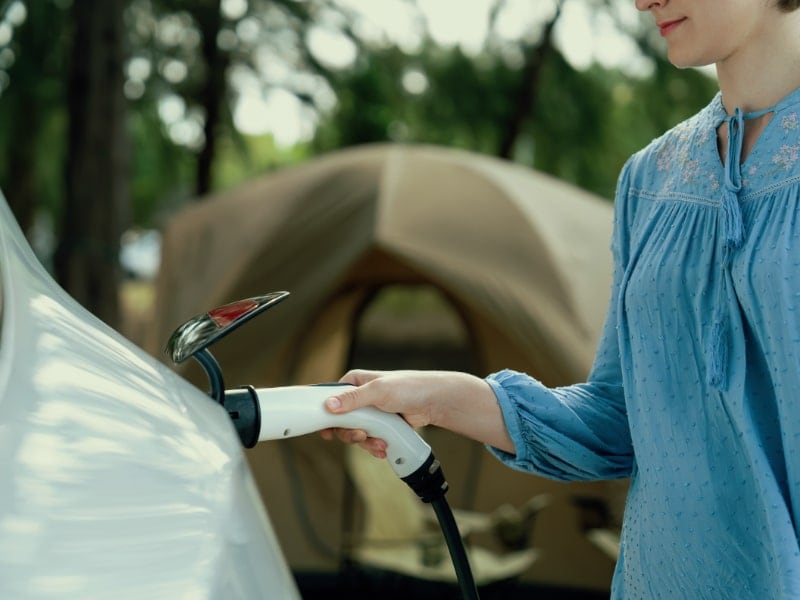
Many campsites in Europe nowadays allow you to charge your electric car.



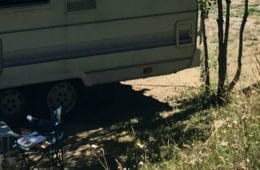
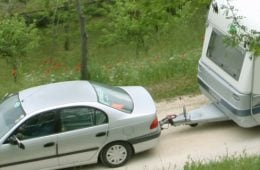






15 Comments
Thank you for the information and comments. Very helpful. I plan to develop an off-grid campsite and am concerned about the amount of power used and the cost of infrastructure I will need to invest in to provide hookups for caravans and campers. Someone suggested I can limit the amonunt used per day per polt to ensure no one drains the battaries and everyone have enough power to share. Any recommendation on how to set a fair limit?
It is quite common on French campsites to find that the supply has reverse polarity. There are cheap testers available to check the polarity and it can be corrected easily by using a cable between the supply and your connection that has been wired the ‘wrong’ way round.The importance of having the correct polarity is that appliances are switched on the live side so when switched off are safe but would still be ‘live’ when switched off if the polarity is incorrect.
It is quite common on French campsites to find that the supply has reverse polarity. There are cheap testers available to check the polarity and it can be corrected easily by using a cable between the supply and your connection that has been wired the ‘wrong’ way round.The importance of having the correct polarity is that appliances are switched on the live side so when switched off are safe but would still be ‘live’ when switched off if the polarity is incorrect.
Some useful information but no mention of reverse polarity.
My Dutch flat was originally 110 volt, it converted to 230 volts in 1960! Other than that, I have never come across 125 volts in Germany, Belgium or France.
We live in Spain and a lot of the campsites here give you an allowance per day ( eg 4 kwatts per day) so if you want to keep a check on your consumption you can purchase an electrical consumption meter. You can connect it in-line with your cable to keep a check on overhaul consumption and check what you’re using at any time.
Many Campsites, Hotels etc on the continent use 125 volt outputs; your article does not mention this. This reduced voltage can have an effect on how efficient your appliances will be and the amount of Wattage you can use:
125Volts? In Europe??
I have never come across 125v supply anywhere
An excellent explanation for ordinary guys life myself ….all in layman terms
Where???
125V was used ages ago…..
A good app to use for calculating watts/amps is Ohm’s Law Calculator. Very simple to use
Hello
The article mentions power limiters that can be purchased .
Can anyone steer me towards them as I cannot find anything suitable.
Johns
One you didn’t mention. On arrival plug the power lead into the van first, then the supply. I have seen many people wandering around with a live lead in their hand.
On departure, remove power first.
Thank you for this article regarding electricity usage. I’ve made a quick reference card from the details here and will keep it to hand, just like the one with my vehicle’s dimensions. Invaluable.